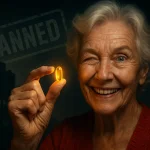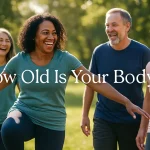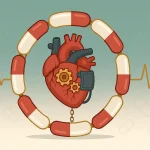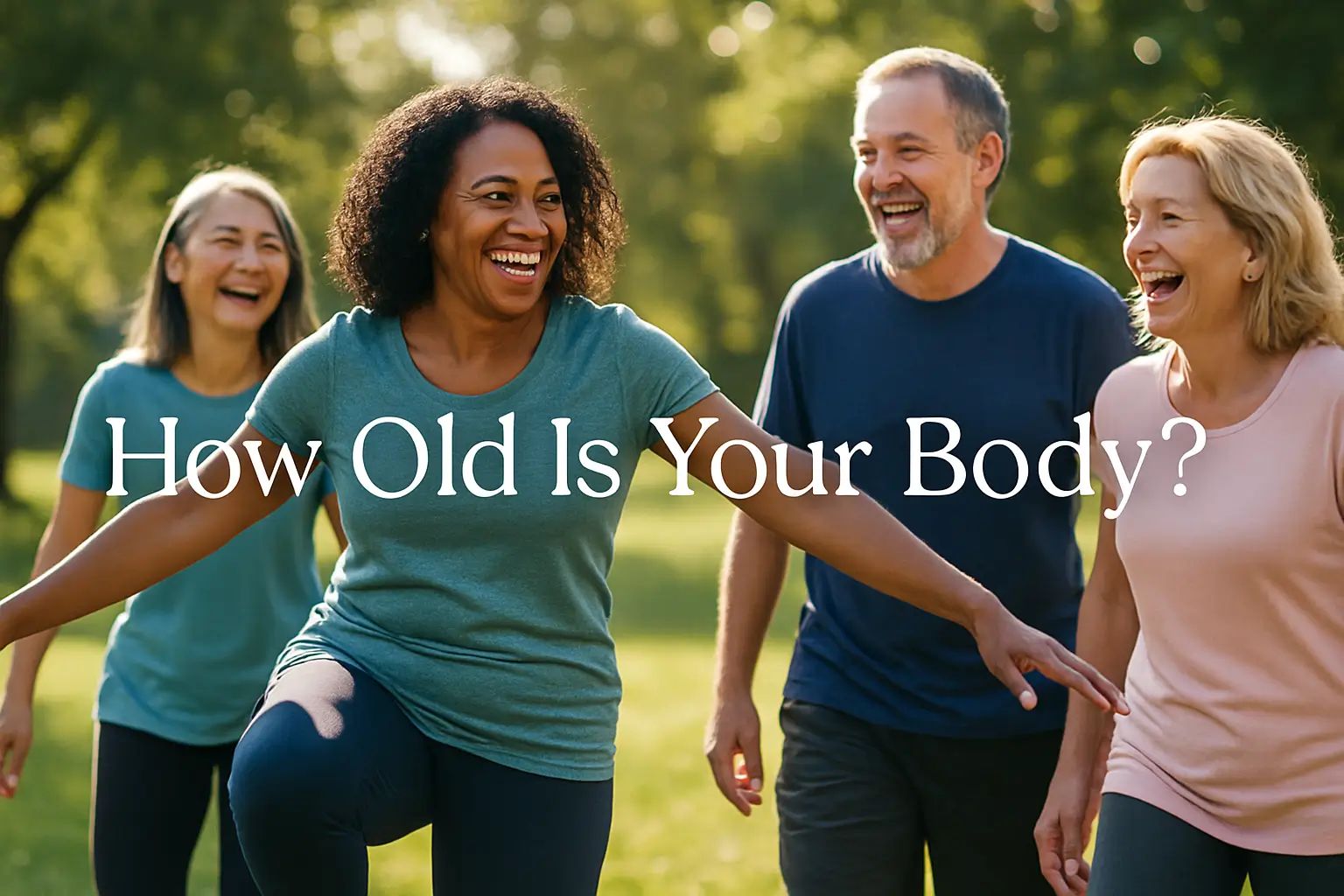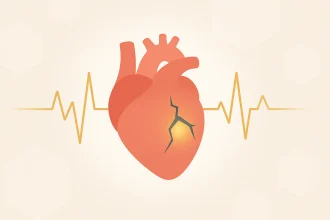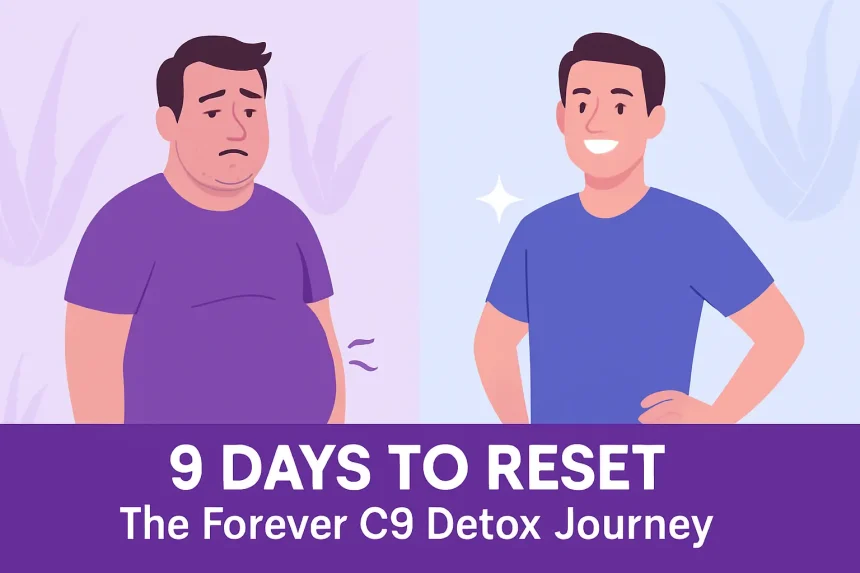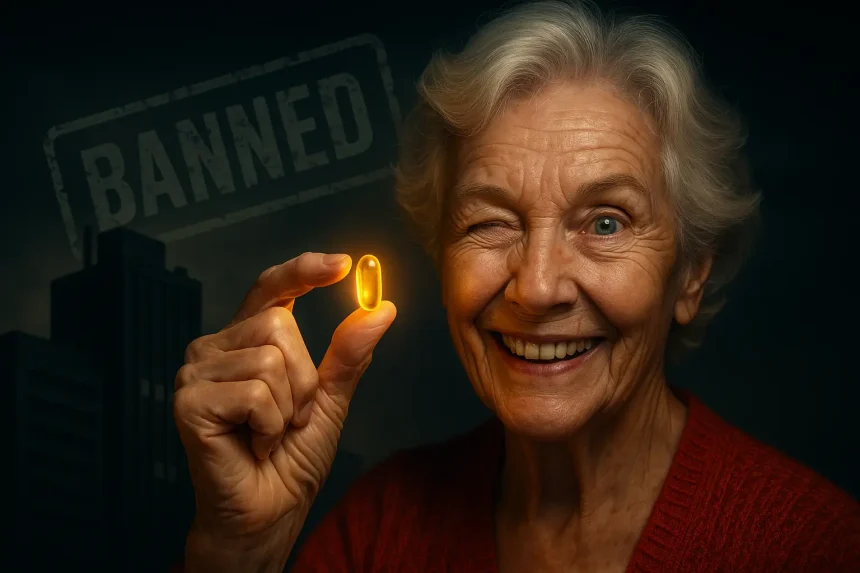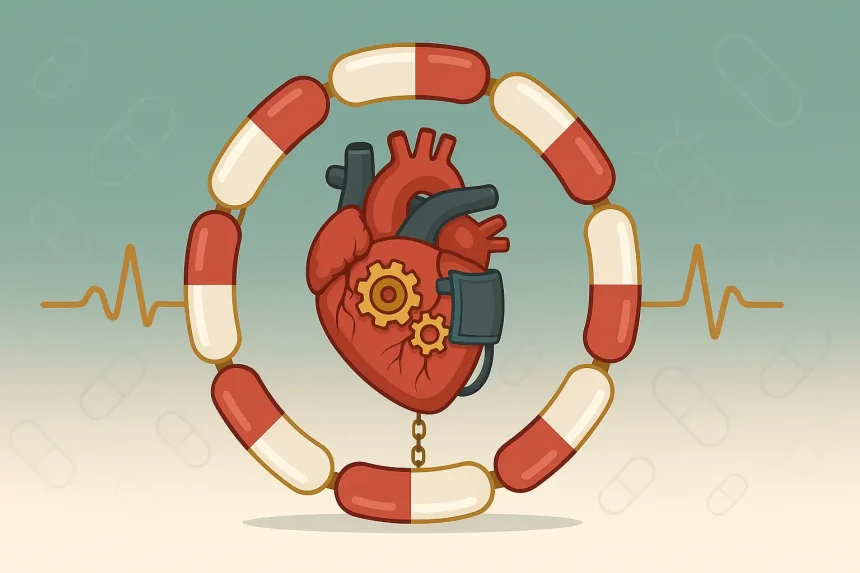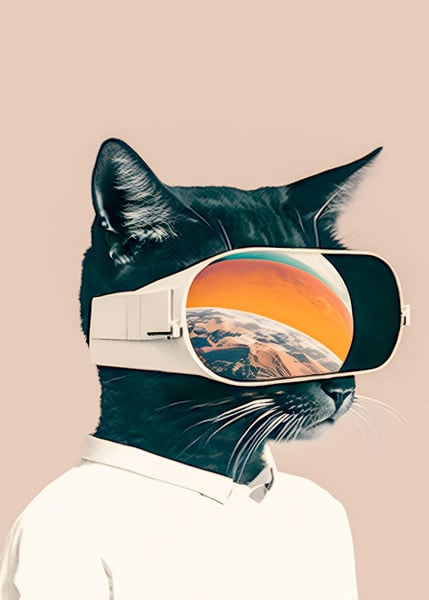Alright, let’s talk about something that’s probably been on your mind – stand on one leg.
Maybe it creeps in when you’re trying to read your phone, and the darn text seems blurrier than it used to.
- The Astonishing Truth: What Your Ability to Stand On One Leg Reveals
- My Own “Stand On One Leg” Experiment: More Than Just Balance
- But Wait, Let’s Not Jump to Conclusions: Understanding the Science
- Why Bother With Balance? The Real “Stand On One Leg Benefits”
- Unpacking the “Stand On One Leg Meaning”: What’s It Really Telling You?
- Ready to Try? The Official “Stand On One Leg Test” Protocol
- The Next Level Challenge: “Stand On One Leg With Eyes Closed Test”
- Decoding Your Results: The “Stand On One Leg Age Test” (Unofficial Guide)
- Why You Might Be Wobbling: Common Culprits and “How to Stand On One Leg Without Wobbling”
- The “Stand On One Leg Muscles Worked”: Your Body’s Balancing Act
- Simple “Stand On One Leg Exercise” Variations to Boost Your Balance
- The Eyes Closed Enigma: “Stand On One Leg Eyes Closed Life Expectancy” and Other Mysteries
- The Curious Case of Critters: “Why Do Flamingos Stand On One Leg?” And Other Avian Acrobats
Or perhaps it’s that morning stiffness, that feeling when you swing your legs out of bed and your body groans a little.
You know, those little aches and pains that seem to hang around longer than they should.
I was chatting with my wife about this exact thing the other night.
Complaining, really.
“My vision’s getting worse,” I said. “I feel so stiff in the mornings, and this stupid injury is taking forever to heal.”
She just looked at me and said, “Well, yeah, you’re 44. That’s when things start to head downhill.”
Ouch, right?
Forty-four. It sounded so specific.
I always figured 50 was the big milestone everyone talked about, the supposed “over the hill” moment.
But she insisted, “Nope. It’s a thing. 44 and 60. There’s a drop-off there.”
And you know what? The woman was right.
My brilliant spouse, always a step ahead.
Turns out, there’s actual science to back this up.
A fascinating study, published in Nature Aging back in August of 2024, dug deep into this.
They looked at a massive amount of data – tons of proteins and metabolites in people of all different ages.
And when they crunched all the numbers, they found significant shifts in our body chemistry over time.
Guess when those changes really peak?
Yep. Around age 44 and again at age 60.
I really should learn not to doubt her.
But here’s the thing, deep down, I’m a firm believer in that old saying: “age is just a number.”
I don’t really care if the calendar says I’m 44, or 50, or even 60.
What I do care about is how my body and my brain are actually aging.
You feel me on this?
If I can be a vibrant, sharp, healthy 80-year-old, still full of life and in full command of my faculties…
Well, that’s a massive win in my book, no matter how many candles are on the cake.
So, I’m always on the lookout for ways to understand how my body is really doing, beyond just birthdays.
And guess what?
According to some compelling new research, there’s a surprisingly simple way to get a clue.
Are you ready for it?
Just stand on one leg.
Yeah, you heard that right.
The Astonishing Truth: What Your Ability to Stand On One Leg Reveals
It sounds almost too simple, doesn’t it?
Like something you’d do in a kid’s game.
But the insights from this simple action are pretty profound.
This surprising discovery comes from a study highlighted in PLOS One.
Researchers analyzed 40 individuals – half under 65, and half over 65.
They looked at a whole range of things: strength, balance, how people walk.
The big question they were trying to answer was this:
We all know things like strength and balance tend to decline as we get older.
But what declines the fastest?
What single thing could be the best, simplest indicator of how our bodies are truly aging, physically?
To figure this out, they measured correlations.
Basically, how different physical abilities stacked up against a person’s calendar age.
Let’s look at a couple of examples they found.
Take grip strength.
Longevity researchers have been interested in grip strength for a long time.
And sure enough, the study showed a connection.
As age went up, grip strength generally went down.
It’s a weak correlation, but it’s there.
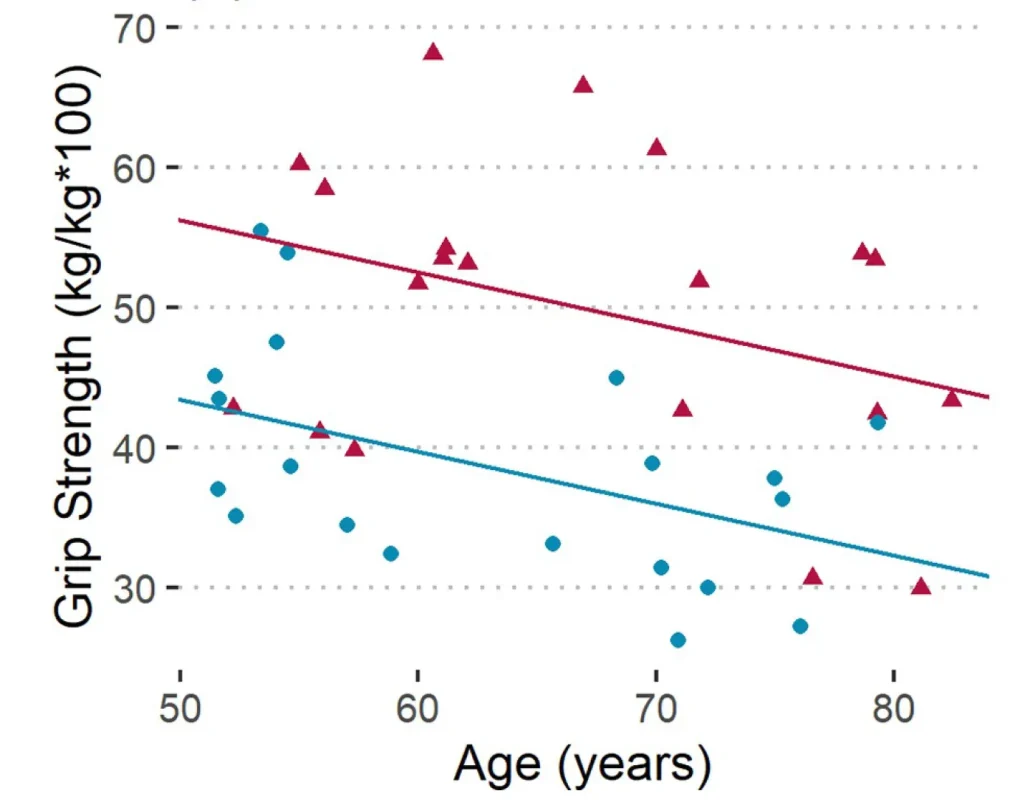
Interestingly, men (shown in pink in their charts, go figure) generally had higher grip strength.
Women (in blue, equally confusing) had lower grip strength overall.
They saw somewhat similar, though less strong, correlations for knee strength.
Makes sense, right? We expect these things.
But then they got to balance. This is where it gets really interesting.
How do you even measure balance scientifically?
Well, these researchers had participants stand on one leg on a special pressure plate.
First, with their eyes open.
Then, with their eyes closed – which is a whole different ballgame, as you can imagine.
They measured how much people swayed.
Essentially, how much their center of pressure wobbled around while they were trying to stay still.
No surprise, sway increased with age.
The older folks swayed more.
And everyone swayed more when their eyes were closed. Vision plays a huge role in balance, after all.
But here’s the kicker.
The strongest link they found.
The metric that correlated most closely with calendar age wasn’t grip strength, or knee strength, or even how much you swayed with your eyes open.
It was this:
How long can you stand on one leg?
Simple. Yet incredibly revealing.
Especially when people tried to stand on one leg using their non-dominant leg.
You know, the one that feels a bit weaker, a bit less coordinated.
The data showed a pretty dramatic drop-off in balance time around age 65.
Younger people? They could often hold the pose for 10 seconds, no problem. Easy peasy.
But some of the older individuals? They struggled to even make it to 2 seconds.
Think about that for a moment.
A potential five-fold difference.
My Own “Stand On One Leg” Experiment: More Than Just Balance
Of course, being the curious (and slightly competitive) guy I am, I had to try this myself.
Right there, in my living room.
And as I was wobbling around, trying to stand on one leg, it hit me.
I understood why this might be such a potent metric.
It’s not just about balance, though that’s a huge part of it.
You’re trying to keep your entire body upright over this tiny little base of support – just one foot.
That’s a massive challenge for your body’s internal gyroscopes.
But it’s also about strength.
Seriously.
One leg is doing all the work, holding up your entire body weight.
After just a short while, you start to feel it.
The muscles in your foot, your ankle, your calf, your thigh, even your glutes and core – they’re all firing.
So yeah, this simple “stand on one leg test” immediately passed the smell test for me.
It feels right.
It genuinely seems like a solid proxy for that age-related physical decline we’re all hoping to slow down.
It’s a test that integrates so many different physical systems.
But Wait, Let’s Not Jump to Conclusions: Understanding the Science
Now, before you rush off and make “stand on one leg” your new Olympic sport, let’s be clear about what this study tells us, and what it doesn’t.
It’s important to keep a level head, even when we’re excited about new information.
The study I mentioned, the one in PLOS One, was a cross-sectional study.
What does that mean?
It means they looked at a bunch of different people, all at different ages, at one single point in time.
They weren’t tracking the same people over many years to see how their ability to stand on one leg changed as they specifically aged.
That would be a longitudinal study – and those are super valuable, but also take a lot longer to do.
Also, when scientists use something called a “correlation coefficient” in graphs, like the ones showing how balance time drops with age…
It often implies a smooth, linear relationship.
Like, for every year older you get, your balance time goes down by a neat, predictable amount.
But if you look closely at the raw data – the actual points on their graph – it doesn’t look quite so perfectly linear to my eye.
As I mentioned earlier, it seems like there might be a bit of a sharper drop-off.
Perhaps around those mid-60s, as the initial data suggested.
What’s the implication of that?
Well, it means we might not be able to use this “stand on one leg test” as a super-sensitive early warning system that gradually changes year by year.
It might be more like you’re pretty good at standing on one leg for a long time…
Until, seemingly all of a sudden, you’re not.
If that’s the case, it gives us less of a gentle warning and maybe less time to act proactively based on tiny declines.
This is why understanding the “stand on one leg meaning” fully requires looking at all angles.
And here’s another really important point.
We don’t definitively know from this study that improving your time to stand on one leg will automatically make you healthier or reverse your biological age.
I’m sure a skilled physiatrist or a good physical therapist could cook up a set of exercises to boost anyone’s standing-on-one-leg time.
And no doubt, with dedicated practice, you could get your numbers way, way up.
You could probably be “standing on one leg for 5 minutes” if you trained for it!
But does that mean you’ve truly become fundamentally healthier or biologically younger?
Not necessarily.
It’s a bit like “teaching to the test.”
You know, when students cram specific answers to score better on a standardized exam, but they haven’t truly mastered the underlying material.
They aced the test, but did they really learn?
Similarly, improving your score on the “stand on one leg test” is great, but it’s the underlying improvements in strength, balance, and coordination that really count for your overall health.
So, am I personally adding hours of one-legged standing to my daily exercise routine?
Not exactly.
But I won’t lie.
From time to time, and especially when my 60th birthday rolls around, you might just find me channeling my inner flamingo, stopwatch in hand, trying to stand on one leg.
Because even with the caveats, it’s a fascinating piece of the puzzle, isn’t it?
Why Bother With Balance? The Real “Stand On One Leg Benefits”
Okay, so we’ve talked about the test. We’ve talked about the science.
But you might be sitting there thinking, “Alright, I get it, balance is important. But how important?”
Let’s dig into the real-world “stand on one leg benefits” because they are far-reaching.
This isn’t just about avoiding a wobble.
First off, and this is a big one, especially as we get older: reducing the risk of falls.
Falls are a massive health concern for seniors.
According to the CDC (Centers for Disease Control and Prevention), falls are the leading cause of injury and injury death in adults aged 65 and older.
That’s serious stuff.
Improving your ability to stand on one leg, and therefore your overall balance, can directly translate to better stability and a lower chance of taking a dangerous tumble.
Think about navigating uneven sidewalks, or stepping off a curb. Good balance is your best friend.
But it’s not just about preventing disaster.
Good balance, the kind you cultivate when you practice your “stand on one leg exercise,” contributes to improved athletic performance.
Whether you’re a weekend warrior, a golfer, a tennis player, or even just enjoy a brisk walk, balance is foundational.
It allows for more efficient movement, better power transfer, and greater agility.
Many athletes intentionally incorporate single-leg exercises to enhance these very qualities.
Then there’s better posture.
Surprised?
When you work on your ability to stand on one leg, you’re engaging your core muscles in a big way.
These are the deep stabilizing muscles of your torso.
Strong core muscles are essential for maintaining good posture, which in turn can alleviate back pain and improve your breathing.
And get this – there’s even a connection to enhanced cognitive function.
Sounds wild, right? But research is starting to show links between physical balance and brain health.
A study published in Scientific Reports found that balance training can actually induce neuroplasticity, meaning it can help your brain reorganize itself by forming new neural connections.
The focus and body awareness required to stand on one leg successfully can be a mini-workout for your brain too!
Let’s not forget increased body awareness, or what scientists call proprioception.
This is your sense of where your body parts are in space without having to look at them.
When you stand on one leg, you’re tuning into the tiny signals from your muscles and joints.
This heightened awareness can help you move more gracefully and efficiently in everything you do.
And finally, think about the daily life improvements.
Things you probably take for granted right now.
Climbing stairs without clutching the handrail.
Carrying a heavy basket of laundry.
Bending down to tie your shoes.
Reaching for something on a high shelf.
All these everyday movements require a degree of balance.
The better your ability to stand on one leg, the easier and safer these tasks become.
So, the “stand on one leg benefits” aren’t just abstract; they touch nearly every part of your active life.
Unpacking the “Stand On One Leg Meaning”: What’s It Really Telling You?
When we talk about the “stand on one leg meaning,” we’re going deeper than just a stopwatch reading.
What does it truly signify if you can hold that pose with ease, or if you find yourself tumbling over after a few seconds?
At its core, your ability to stand on one leg is a reflection of how well several critical body systems are working together.
It’s like a symphony orchestra – every section needs to be in tune and playing its part.
First, there’s your musculoskeletal system.
This includes the “stand on one leg muscles worked,” which are numerous.
We’re talking about the small intrinsic muscles in your feet, adjusting constantly.
Your ankle stabilizers, working overtime.
Your powerful calf muscles (gastrocnemius and soleus).
Your quadriceps and hamstrings in your thigh, co-contracting for stability.
Your gluteus medius and minimus (hip abductors), crucial for keeping your pelvis level.
And, of course, your deep core muscles, acting as the central anchor.
If any of these muscle groups are weak or deconditioned, your one-legged stance will suffer.
Second, there’s your nervous system.
Specifically, your proprioceptive system, as we touched on.
This is your body’s internal GPS.
Sensory receptors in your skin, muscles, and joints send a constant stream of information to your brain about your position, movement, and the forces acting on your body.
Your brain then processes this information and sends signals back to your muscles to make tiny, rapid adjustments to keep you upright.
If this communication pathway is sluggish or impaired, your ability to stand on one leg will be compromised.
Third, your vestibular system.
This is located in your inner ear and is responsible for your sense of balance and spatial orientation.
It detects motion, head position, and spatial orientation.
It helps you know which way is up, even if your eyes are closed.
A well-functioning vestibular system is critical for maintaining equilibrium, especially in challenging balance situations like the “stand on one leg with eyes closed test.”
And fourth, though not always thought of in this context, your visual system.
Your eyes provide a huge amount of information to your brain about your surroundings, helping you orient yourself and make anticipatory postural adjustments.
That’s why it’s so much harder to stand on one leg with eyes closed.
When you remove vision, you’re relying much more heavily on your proprioceptive and vestibular systems.
So, if you’re struggling to stand on one leg, it could indicate an issue in one or more of these areas.
It might be muscle weakness.
It could be reduced proprioceptive feedback, perhaps due to age or injury.
It might even suggest that your vestibular system isn’t as sharp as it could be.
The “stand on one leg meaning,” therefore, is a holistic indicator of your functional health.
It’s a quick, accessible window into how well these intricate systems are integrated.
Ready to Try? The Official “Stand On One Leg Test” Protocol
So, you’re curious. You want to know where you stand (pun intended!).
Let’s walk through how to perform the “stand on one leg test” properly so you can get a reliable idea of your current balance abilities.
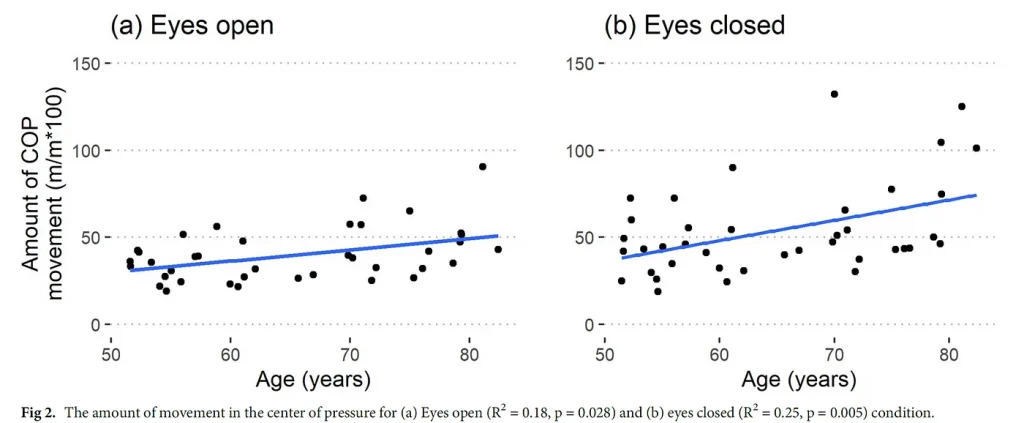
No fancy equipment needed. Just you, a bit of space, and maybe a stopwatch (your phone has one).
Before You Start:
- Choose a safe, flat surface. Avoid plush carpets if possible, as they can make it harder. A firm floor is best.
- Stand near a wall or sturdy chair, just in case you need to reach out for support. Safety first!
- Remove your shoes. Doing this barefoot or in thin socks gives you better sensory feedback from your feet.
The “Stand On One Leg Test” – Eyes Open:
- Starting Position: Stand tall with your feet together, arms comfortably at your sides or hands on your hips. Some people prefer to “cross arms and stand on one leg,” which can sometimes help with a stable center of gravity. Experiment to see what feels natural but be consistent.
- Lift One Leg: When you’re ready, gently lift one foot off the ground. Bend the knee of the lifted leg so your foot is about mid-calf height of your standing leg. Don’t let your legs touch.
- Focus: Pick a spot on the wall in front of you at eye level and focus on it. This will help you maintain balance.
- Time Yourself: Start the timer as soon as your foot leaves the ground. Stop the timer if:
- Your lifted foot touches the ground.
- Your standing foot hops or moves from its spot.
- Your arms flail out excessively to maintain balance (minor adjustments are okay).
- Your lifted leg touches your standing leg for support.
- Record Your Time: Note down how long you were able to stand on one leg.
- Repeat on the Other Side: Rest for a moment, then repeat the test on your other leg. Most people have a dominant and non-dominant side, and it’s common to see a difference.
- Do a Few Trials: It’s a good idea to do 2-3 trials on each leg and take your best time, or an average, to account for any initial wobbles or learning effects.
This is your baseline “stand on one leg” ability with your eyes open.
The Next Level Challenge: “Stand On One Leg With Eyes Closed Test”
Ready to up the ante?
The “stand on one leg with eyes closed test” is significantly more challenging because it removes your primary source of sensory information for balance – your vision.
This really puts your proprioceptive and vestibular systems to the test.
The “Stand On One Leg With Eyes Closed Test” Protocol:
- Starting Position: Same as before – stand tall, feet together, arms at your sides or on your hips.
- Close Your Eyes First: Before you lift your leg, close your eyes and take a moment to feel centered.
- Lift One Leg: When you’re ready, with your eyes still closed, gently lift one foot off the ground to that mid-calf position.
- Time Yourself: Start the timer. Stop it under the same conditions as the eyes-open test (foot down, hopping, arms flailing, leg touching).
- Record Your Time: This time will likely be much shorter. Don’t be discouraged!
- Repeat on the Other Side: Test your other leg with eyes closed.
- Safety Note: Be extra cautious with this one. Make sure you’re very close to that wall or chair for support, as it’s much easier to lose your balance quickly when your eyes are closed.
Now you have two sets of numbers: your time for each leg with eyes open, and your time for each leg with eyes closed.
What do these numbers mean? Let’s explore that.
Decoding Your Results: The “Stand On One Leg Age Test” (Unofficial Guide)
Okay, so you’ve done the tests. You have your times.
Now you’re probably wondering, “How did I do? Is my balance ‘good’ for my age?”
This is where the concept of a “stand on one leg age test” comes in.
It’s important to state upfront: there isn’t one single, universally agreed-upon chart that definitively says “if you’re X age, you must be able to stand on one leg for Y seconds.”
Research varies, and individual abilities differ greatly.
However, we can look at some general findings from studies to get a ballpark idea.
General Observations (Eyes Open, Non-Dominant Leg):
- Younger Adults (Under 40): Often can hold for 30 seconds or even much longer, sometimes up to the test ceiling (e.g., 60 seconds in some studies). Many find it relatively easy.
- Middle-Aged Adults (40-60): You might see times ranging from 20-40 seconds. A gradual decline may start to be noticeable, especially if you’re not actively working on balance.
- Older Adults (60-69): The original study mentioned a significant drop-off around 65. Times might range from 10-30 seconds. The ability to hold for over 20 seconds is generally considered good.
- Older Adults (70-79): A wider range here. Some active individuals may still manage 15-25 seconds, while others might be closer to 5-10 seconds. The “if you cant stand on one leg for 20 seconds” benchmark becomes more critical here as an indicator for fall risk.
- Adults 80+: Balance can be a significant challenge. Being able to hold for 5-10 seconds is a good sign. Some may struggle to reach even a few seconds.
How long should you be able to stand on one leg?
Many clinicians use 10 seconds as a critical threshold for older adults.
An influential study published in the British Medical Journal (Claudio Gil Araújo et al., 2022) involving middle-aged and older individuals found that an inability to complete a 10-second one-legged stance was associated with a nearly doubled risk of all-cause mortality over the next 7 years.
That’s a sobering statistic and really underscores the importance of this simple test.
So, if you’re consistently under 10 seconds, especially if you’re over 50, it’s definitely something to pay attention to.
If you cant stand on one leg for 20 seconds” – what does that mean?
If you’re under, say, 60 and consistently can’t reach 20 seconds on your non-dominant leg with eyes open, it suggests your balance could definitely use some improvement.
It might not be cause for immediate alarm, but it’s a signal.
It indicates that your strength, proprioception, or the coordination between them isn’t optimal.
This is your cue to take proactive steps.
What about the “Stand On One Leg With Eyes Closed Test”?
This is much harder, and times will be significantly shorter across all age groups.
How long should i be able to stand on one leg with eyes closed?
- Younger Adults: Might manage 15-30 seconds or more.
- Middle-Aged Adults: Perhaps 5-15 seconds.
- Older Adults: Even a few seconds (2-5) can be a good achievement. Many may not be able to do it at all without practice.
The “stand on one leg eyes closed life expectancy” link is less directly studied with specific time-based mortality risks like the 10-second eyes-open test.
However, a very poor performance here (e.g., inability to even lift the foot without losing balance immediately) clearly indicates a heavy reliance on vision for stability and potential issues with the proprioceptive or vestibular systems. This, indirectly, could contribute to fall risk and associated health decline.
Remember, these are just general guidelines for the “standing on one leg age test.”
Don’t fixate too much on one specific number.
The key is to understand your own baseline and then work towards improving it or maintaining it as you age.
The “stand on one leg challenge” is primarily a challenge against your former self.
Why You Might Be Wobbling: Common Culprits and “How to Stand On One Leg Without Wobbling”
So, you tried the “stand on one leg test” and found yourself doing more of a wobble dance than a serene flamingo impression.
You’re not alone! Many people find it surprisingly challenging.
Let’s explore some common reasons why you might be struggling and then get into practical tips on “how to stand on one leg without wobbling.”
Common Reasons for Wobbling:
- Weak Stabilizer Muscles: This is a big one. The small muscles in your feet and ankles, your hip abductors (especially gluteus medius), and your deep core muscles are all crucial for maintaining balance. If they’re weak or deconditioned, you’ll wobble. These are key “stand on one leg muscles worked.”
- Poor Proprioception: Your body’s ability to sense its position in space might be diminished. This can happen with age, due to inactivity, or from previous injuries (like ankle sprains) that weren’t fully rehabilitated.
- Stiff Ankles or Hips: Limited range of motion in your ankle or hip joints can restrict your ability to make those subtle adjustments needed for balance. If your ankle can’t flex or extend properly, your body has to compensate elsewhere, often leading to instability.
- Incorrect Technique: Sometimes, it’s just how you’re approaching it. Are you looking down? Tensing up too much? Holding your breath? These things can throw you off.
- Trying Too Hard Too Soon: If you haven’t done balance exercises before, your body simply isn’t used to the demand. You need to build up to it.
- Vestibular System Issues: Less common, but if you experience dizziness or vertigo, issues with your inner ear’s balance system could be a factor. This is something to discuss with a doctor.
- Fear of Falling: Ironically, being afraid of falling can make you tense and more likely to lose your balance.
Tips: How to Stand On One Leg Without Wobbling
Improving your one-legged stance is a skill. And like any skill, it gets better with practice and the right technique.
- Start with Support: Don’t be a hero. If you’re wobbly, lightly touch a wall or the back of a chair with one or two fingers. Gradually reduce the support as you get steadier.
- Focus Your Gaze (Drishti): In yoga, this is called “Drishti.” Pick a non-moving spot on the wall in front of you, about eye level. Keep your gaze soft but focused. Avoid looking around or down at your feet.
- Engage Your Core: Gently draw your belly button towards your spine. This activates your deep core muscles, providing a stable center. Don’t suck in so hard you can’t breathe, just a gentle engagement.
- Grip the Floor with Your Standing Foot: Imagine your standing foot has roots growing down into the floor. Spread your toes and try to create a “tripod” with your big toe, little toe, and heel, distributing your weight evenly.
- Keep a Slight Bend in Your Standing Knee: Don’t lock your knee. A micro-bend acts as a shock absorber and allows for tiny adjustments.
- Align Your Hips: Try to keep your hips level. It’s common for the hip of the lifted leg to drop or for the standing hip to jut out. Think of headlights on your hip bones, both pointing straight ahead.
- Breathe! Many people unknowingly hold their breath when concentrating. Breathe slowly and steadily.
- Start with Shorter Holds: Don’t aim for a minute right away. Try for 5 seconds with good form. Then 10. Gradually increase the duration. Quality over quantity.
- Practice “Micro-Dosing” Balance: This is where “stand on one leg while brushing teeth” comes in. Small, frequent bursts of practice are often more effective than one long, infrequent session.
- Strengthen Key Muscles: Incorporate exercises that target your ankles, calves, glutes (especially gluteus medius), and core. We’ll cover specific “stand on one leg exercise” variations soon.
By consciously applying these tips, you’ll start to notice a real difference in your ability to stand on one leg with more confidence and less wobbling.
The “Stand On One Leg Muscles Worked”: Your Body’s Balancing Act
When you stand on one leg, it might seem simple, but there’s a complex orchestra of muscles playing in perfect harmony (or trying to!). Understanding the “stand on one leg muscles worked” can help you appreciate the effort and even target these muscles for improvement.
Let’s break it down from the ground up:
- Intrinsic Foot Muscles: These tiny muscles within your foot are working like crazy. They make constant, minute adjustments to grip the floor and adapt to shifts in your center of gravity. Think of them as the fine-tuners.
- Ankle Muscles:
- Tibialis Anterior (front of shin): Helps lift your foot (dorsiflexion) and plays a role in controlling forward sway.
- Peroneals (outside of lower leg): Crucial for preventing your ankle from rolling outwards (eversion) and for lateral stability.
- Calf Muscles (Gastrocnemius & Soleus): While primarily for pointing your foot down (plantarflexion), they are very active in stabilizing the ankle joint and controlling backward sway.
- Knee Muscles:
- Quadriceps (front of thigh): Work to keep your knee extended but not locked.
- Hamstrings (back of thigh): Co-contract with the quads to stabilize the knee joint.
- Hip Muscles: This group is incredibly important!
- Gluteus Medius & Minimus (side of hip/buttock): These are the superstars of single-leg stance. They prevent your pelvis from dropping on the side of the lifted leg (a common issue called Trendelenburg sign). If these are weak, your stability will be severely compromised.
- Gluteus Maximus (main buttock muscle): Helps with hip extension and overall stability.
- Hip Flexors (front of hip): Active in lifting the non-standing leg, but also play a role in pelvic stability.
- Adductors (inner thigh): Help to stabilize the pelvis and standing leg.
- Core Muscles:
- Transversus Abdominis (deepest abdominal muscle): Acts like a corset to stabilize your spine and pelvis.
- Obliques (sides of your abdomen): Help control rotation and lateral flexion of the trunk.
- Erector Spinae (muscles along your spine): Keep your back straight and stable.
- Multifidus (small muscles deep in the back): Provide fine-tuned spinal stability.
Essentially, to successfully stand on one leg, your body recruits a chain of muscles starting from your foot, moving up through your leg and hip, and engaging your core to create a stable pillar.
It’s a full-body effort, even though it seems localized to one leg.
This is why the “stand on one leg exercise” is such an efficient way to build functional strength.
If you’re looking to support these hard-working muscles and joints, ensuring your body has the right building blocks is key.
For instance, products like Forever Freedom® are designed with ingredients such as glucosamine, chondroitin, and MSM, which are popular for supporting joint comfort and flexibility. When your joints feel good, your muscles can perform better.
Additionally, maintaining good hydration and electrolyte balance is crucial for muscle function. Consider FLP’s Aloe Vera Gel drinks, which can support digestion and nutrient absorption, helping you get the most from your diet to fuel these muscles.
ARGI+® also provides L-Arginine and a vitamin complex that supports nitric oxide production, which can benefit circulation and muscle performance during exercise.

Forever ARGI+®
Provides L-Arginine and a vitamin complex that supports nitric oxide production, which can benefit circulation and muscle performance during exercise.
Simple “Stand On One Leg Exercise” Variations to Boost Your Balance
Okay, you understand the importance, you know how to test yourself, and you know which muscles are involved.
Now, let’s get practical with some “stand on one leg exercise” variations you can easily incorporate into your routine.
The goal here is progressive challenge. Start where you’re comfortable and gradually make it harder.
Beginner Exercises (Focus on Stability):
- Supported One-Leg Stand:
- Stand near a wall or chair, lightly touching for support.
- Lift one leg, focusing on good form (level hips, engaged core, focused gaze).
- Hold for 10-30 seconds. Repeat 2-3 times per leg.
- Gradually reduce your reliance on the support.
- Heel-to-Toe Walk (Tandem Stance/Walk):
- While not strictly a one-leg stand, this drastically narrows your base of support and challenges balance.
- Walk in a straight line, placing the heel of one foot directly in front of the toes of the other.
- Try 10-15 steps. Use a wall nearby if needed.
- Weight Shifts:
- Stand with feet hip-width apart.
- Slowly shift your weight onto one leg, lifting the other foot just an inch or two off the floor.
- Hold for a second, then shift back to the center, then onto the other leg.
- Repeat 10-15 times per side. This helps you feel the engagement of your stabilizing muscles.
Intermediate Exercises (Adding Movement & Challenge):
- One-Leg Stand with Arm Reaches:
- Stand on one leg.
- Slowly reach one arm forward, then to the side, then overhead.
- Focus on maintaining balance as your center of gravity shifts.
- Perform 5-10 reaches in each direction per leg.
- One-Leg Stand with Head Turns:
- Stand on one leg.
- Slowly turn your head to look to the right, then back to center. Then to the left, back to center.
- Then, slowly tilt your head up towards the ceiling, back to center. Then down towards the floor, back to center.
- This challenges your vestibular system. Start with small, slow movements.
- Clock Exercise/Leg Reaches:
- Stand on one leg (e.g., left leg).
- Imagine you’re in the center of a clock face.
- With your lifted leg (right leg), slowly tap your toe forward (12 o’clock), then bring it back.
- Then tap to the side (3 o’clock for right leg, or 9 o’clock if standing on right leg and tapping left), then back.
- Then tap behind you (6 o’clock), then back.
- Keep your standing leg stable and your core engaged. Repeat 3-5 “clocks” per leg.
Advanced Exercises (Higher Demand):
- One-Leg Stand on an Unstable Surface:
- Try standing on a pillow, a foam balance pad, or a BOSU ball (flat side up or down for varying difficulty).
- This dramatically increases the challenge for your stabilizer muscles and proprioception.
- Start with short durations and ensure safety.
- Single-Leg Deadlift (SLDL):
- Stand on one leg with a slight bend in the knee.
- Hinge at your hips, keeping your back straight, and lower your torso towards the floor while extending your lifted leg straight back behind you.
- Reach towards your standing foot with one or both hands.
- Return to the upright position, squeezing your glutes.
- This is excellent for hamstring, glute, and back strength, plus balance. Start with bodyweight only.
- “Standing On One Leg Yoga Pose Name” – Tree Pose (Vrksasana):
- This is a classic “standing on one leg yoga pose name.”
- Stand on one leg. Place the sole of your lifted foot on your inner thigh (avoiding the knee joint) or calf of your standing leg.
- Bring your hands to your heart center or extend them overhead.
- Hold for 30-60 seconds. This builds strength, balance, and focus.
Making it a Habit: “Stand On One Leg While Brushing Teeth”
This is one of the easiest and most effective ways to sneak in balance practice.
You’re already standing there for two minutes, twice a day. Why not make it productive?
- When you start brushing, lift one leg.
- Try to stand on one leg for 30 seconds or a minute.
- Then switch to the other leg for the remainder of your brushing time.
- If you’re wobbly, just keep your hand near the sink for light support. Over weeks and months, these “balance snacks” add up significantly without requiring extra time in your day. This embodies the “stand on one leg while brushing teeth” philosophy perfectly.
As you increase your activity and try these new exercises, remember to listen to your body.
If you feel any undue strain, especially in your joints, it’s important to ensure you’re supporting your body’s recovery.
Products like Forever Move™, which features NEM® (natural eggshell membrane) and BioCurc® (a bioavailable curcumin complex), are formulated to support joint comfort and flexibility, and can be a great companion to an active lifestyle focused on improving balance and mobility.

Forever Move™
Formulated to support joint comfort and flexibility, and can be a great companion to an active lifestyle focused on improving balance and mobility.
Consider also the benefits of Aloe Heat Lotion for soothing tired muscles after a new workout. Applied topically, its warming agents can provide relief.
The Eyes Closed Enigma: “Stand On One Leg Eyes Closed Life Expectancy” and Other Mysteries
We’ve touched on it, but let’s delve deeper into the fascinating challenge of the “stand on one leg with eyes closed test.”
Why is it so much harder? And what about that intriguing, if slightly alarming, phrase: “stand on one leg eyes closed life expectancy”?
When you close your eyes, you eliminate the dominant sensory input your brain uses to maintain balance: vision.
Your brain is suddenly forced to rely much more heavily on:
- Proprioception: Those signals from your skin, muscles, and joints telling your brain where your body is in space.
- Vestibular System: Your inner ear’s balance organs, detecting head motion and orientation.
If either of these systems isn’t functioning optimally, or if the brain isn’t integrating their signals effectively, standing on one leg with your eyes closed becomes incredibly difficult.
It’s a true test of your internal balance mechanisms.
How long should i be able to stand on one leg with eyes closed?
As mentioned, times are much shorter.
- For younger adults (under 40), anywhere from 10-30+ seconds is often achievable with practice.
- For middle-aged adults (40-60), 5-15 seconds might be a good target.
- For older adults (60+), even 2-5 seconds can be a significant achievement. Many may struggle to hold it for more than a brief moment, if at all, without practice.
The “Stand On One Leg Eyes Closed Life Expectancy” Question:
Let’s be very clear: there are NO direct, large-scale studies that definitively state, “If you can stand on one leg with eyes closed for X seconds, your life expectancy is Y years.”
That would be an oversimplification and likely scientifically unfounded in such precise terms.
However, the concept hints at a few things:
- Fall Risk: Difficulty with eyes-closed balance strongly indicates an increased risk of falling in situations where vision is compromised (e.g., a dimly lit room, walking at night, or when your attention is diverted). Falls, as we know, can lead to injuries that significantly impact health and longevity, especially in older adults.
- Sensorimotor Decline: A very poor ability to balance with eyes closed can be an indicator of more significant underlying sensory or neurological decline. These systems are crucial for overall functional health.
- Integrative Health Marker: Like the eyes-open test, it’s another piece of the puzzle. A robust ability to balance without vision suggests healthy proprioceptive and vestibular systems, which are part of overall vitality.
So, while there isn’t a direct “life expectancy calculator” based on this test, a very poor performance should be seen as a flag. It suggests that key systems for maintaining stability and preventing falls are not working as well as they could be. Improving this ability can contribute to a safer, more active life, which indirectly supports longevity.
Think of it less as a doom-and-gloom predictor and more as valuable information.
If you struggle significantly with the “standing on one leg with eyes closed test,” it’s a strong signal to:
- Practice eyes-closed balance exercises (safely!).
- Focus on strengthening proprioception.
- Consider if there are any underlying issues (like inner ear problems or neurological conditions) that might need a professional look, especially if you experience dizziness or vertigo.
The Curious Case of Critters: “Why Do Flamingos Stand On One Leg?” And Other Avian Acrobats
You’ve seen them, haven’t you?
The elegant flamingo, perfectly poised on a single, slender leg.
Or maybe a seagull on the beach, doing the same.
It makes you wonder, especially when we’re talking so much about humans and their ability to stand on one leg.
So, “why do flamingos stand on one leg?” And what about other birds?
This is a fun detour, but it actually ties back to efficiency and stability in nature.
Let’s look at some of our feathered friends:
“Why do flamingos stand on one leg?” / “Why flamingos stand on one leg”
This has been a subject of scientific curiosity for years! There are a few leading theories:
- Thermoregulation (Conserving Heat): This is a strong contender. Birds lose heat through their featherless legs and feet. By tucking one leg up into their warm body feathers, they reduce the amount of heat lost to cooler water or air by up to 50%. This is especially important for birds like flamingos that spend a lot of time wading in water.
- Reducing Muscle Fatigue: Counterintuitively, standing on one leg might actually be less tiring for flamingos. Research from Georgia Tech (Lena H. Ting and Young-Hui Chang) found that flamingos have a “passively stable gravitational stay apparatus.” This means their joints and ligaments can essentially lock in place, allowing them to stand on one leg with very little active muscle effort. It’s like a biological tripod that snaps into a stable configuration. Humans, unfortunately, don’t have this nifty locking mechanism to the same extent.
- Readiness for Action: While less supported for flamingos specifically, for some birds, having one leg already tucked up might allow for a quicker takeoff or escape if a predator approaches.
Why do birds stand on one leg? (General)
Many of the reasons for flamingos apply to other birds too.
Thermoregulation is a common factor, especially in colder climates or when standing in water.
The muscle fatigue aspect, particularly if they have efficient locking mechanisms in their legs, also plays a role.
It can also simply be a comfortable resting posture for them.
Why do geese stand on one leg?
Similar to flamingos and other wading birds, geese often stand on one leg to conserve body heat, especially when they are in cold water or on icy ground. Tucking one leg up helps reduce heat loss.
Why do seagulls stand on one leg?
You guessed it – primarily thermoregulation. Seagulls are often found near cold ocean waters or in windy coastal areas. Reducing the surface area exposed to the cold by half (by tucking one leg) helps them stay warm.
Why do pigeons stand on one leg?
Pigeons also do it for warmth. You’ll see it more often in colder weather. They might alternate legs to give each one a chance to warm up. It can also be a sign of relaxation or comfort.
Why do chickens stand on one leg?
Chickens will stand on one leg for similar reasons: warmth, especially if the ground is cold or wet. It can also be a resting posture. Sometimes, if a chicken has an injury to one foot or leg, it will favor the other by standing on it, but usually, it’s for comfort or warmth.
Why do owls stand on one leg?
Owls, like other birds, will stand on one leg to conserve heat. They have feathery “trousers” (covering the upper part of their legs) that help, but the lower leg and foot can still lose heat. Tucking one up helps. It’s also a stable resting position for them.
So, while these animals make it look effortless, their reasons are often about survival and energy conservation.
For humans, improving our ability to stand on one leg isn’t so much about staying warm, but about maintaining our functional health, preventing falls, and gauging our physical aging.
But hey, if you want to feel like an elegant flamingo while you practice, go right ahead! The “stand on one leg challenge” can be fun too.
Pushing the Limits: “Standing On One Leg For 5 Minutes” or “Standing On One Leg For 2 Minutes”
We’ve talked about benchmarks like 10 seconds or 30 seconds.
But what about those keywords that pop up: “standing on one leg for 5 minutes” or “standing on one leg for 2 minutes”?
Is this realistic? Is it beneficial? What’s the “standing on one leg for 2 minutes meaning” if you can achieve it?
Is it Possible?
Yes, for some people, especially those with dedicated practice (like yoga practitioners, dancers, or martial artists), “standing on one leg for 5 minutes” or even longer is definitely achievable.
It requires exceptional strength in the stabilizing muscles, excellent proprioception, unwavering focus, and efficient energy use.
Is it Necessary for General Health?
For the average person looking to gauge their functional age and reduce fall risk, being able to stand on one leg for 30 seconds to a minute with good form is likely more than sufficient.
The significant health correlations, like the mortality risk data, are often tied to much shorter durations (e.g., the 10-second mark).
There isn’t strong scientific evidence suggesting that going from, say, a 1-minute hold to a 5-minute hold provides a proportionally massive leap in general health benefits or longevity for most people.
What Does “Standing On One Leg For 2 Minutes Meaning” (or 5 Minutes) Imply?
If you can achieve these longer durations, it certainly indicates:
- Excellent Balance: Obviously.
- Superior Muscular Endurance: Your stabilizer muscles are incredibly fit and resistant to fatigue.
- Exceptional Concentration: Maintaining focus for that long is a mental feat in itself.
- High Level of Body Awareness: You’re very attuned to the micro-adjustments your body is making.
It’s a sign of high proficiency in balance and stability.
For athletes in specific sports, this level of control could be very beneficial.
For someone practicing mindfulness or certain types of yoga, the extended hold can be a meditative practice.
The Downsides of Extreme Durations for Most People:
- Time Investment: The training to get there could be substantial.
- Potential for Strain: Holding static postures for very long periods can sometimes lead to strain if form isn’t perfect or if there are underlying joint issues.
- Diminishing Returns for General Health: The extra minutes might not provide significantly more fall prevention or functional age benefit than a solid 30-60 second hold achieved with good technique.
The Takeaway:
Don’t feel pressured to aim for “standing on one leg for 5 minutes” unless you have a specific reason or passion for it.
Focus on achieving a good, solid, stable hold for a reasonable duration (e.g., 30 seconds per leg, eyes open) as your primary goal for health and aging assessment.
If you want to push it further as a personal “stand on one leg challenge,” great! Just ensure you’re doing it safely.
The ability to stand on one leg consistently and comfortably for a moderate duration is a fantastic indicator of your body’s current functional state.
To support your body if you are aiming for longer durations or more intense balance training, ensuring optimal nutrition is vital.
Forever Lite Ultra® shakes can be a great way to get quality protein for muscle support and recovery, along with essential vitamins and minerals.

Forever Lite Ultra®
A great way to get quality protein for muscle support and recovery, along with essential vitamins and minerals.
When your muscles have what they need to repair and strengthen, you’re better equipped for any physical challenge, including extending your one-legged stance time.
Also, FLP’s Bee Pollen can be a source of natural energy and nutrients that can support stamina during longer practice sessions.

Forever Bee Pollen
Source of natural energy and nutrients that can support stamina during longer practice sessions.
Revisiting the Caveats: A Clear-Eyed View of the “Stand On One Leg” Metric
Remember earlier, I mentioned a few caveats from the original article about the “stand on one leg” research?
It’s important to revisit these, not to diminish the value of the test, but to have a well-rounded, critical understanding. This is how we move from just information to real wisdom.
- Cross-Sectional vs. Longitudinal Studies:
The original study mentioned was cross-sectional – a snapshot in time across different age groups.
This is valuable for identifying correlations, like “older people tend to have less balance time.”
However, it doesn’t track the same individuals over years to see how their specific balance changes as they age and what factors influence that change.
Longitudinal studies give us richer data on individual aging trajectories.- Our Takeaway: While we’d love more longitudinal data (and researchers are always working on it!), cross-sectional studies still provide powerful clues. The correlations found are significant enough to warrant attention. Think of it as a very useful “weather report” for your current physical state, even if it’s not the full climate history.
- The “Sharp Drop-Off” vs. Linear Decline:
The author of the original piece astutely noted that the data might not show a perfectly smooth, linear decline in balance time with age. Instead, there might be a more noticeable “sharp drop-off,” perhaps in the mid-60s for many.- Our Takeaway: This is actually a crucial point. If decline isn’t always gradual, it means we can’t afford to be complacent, thinking, “Oh, I’ll just decline a tiny bit each year.” There could be a more sudden shift. This makes proactive balance training even more important. The goal is to push that “sharp drop-off” as far into the future as possible, or to make its slope much gentler if and when it does occur. Early and consistent practice of your “stand on one leg exercise” can be your best defense.
- “Teaching to the Test” – Are You Really Healthier?
The concern was that you could practice specifically to get good at the “stand on one leg test” without necessarily improving your overall, fundamental health.- Our Takeaway: This is a valid point if your only focus is the number on the stopwatch. However, I’d argue that the very act of practicing to improve your ability to stand on one leg does build real, functional benefits, IF you do it correctly.
- You are strengthening those crucial stabilizer muscles (“stand on one leg muscles worked”).
- You are enhancing your proprioception and your brain’s ability to process those signals.
- You are improving the coordination between your nervous system and musculoskeletal system.
- These improvements will translate to better balance in everyday life, reducing fall risk and enhancing mobility.
- Our Takeaway: This is a valid point if your only focus is the number on the stopwatch. However, I’d argue that the very act of practicing to improve your ability to stand on one leg does build real, functional benefits, IF you do it correctly.
The key is to focus on quality of movement and the feeling of stability, not just chasing seconds.
If you’re wobbling precariously but manage to hit 15 seconds, that’s less beneficial than a super stable, controlled 10-second hold.
So, yes, “teach to the test,” but understand that this particular “test” involves developing genuine physical skills that are intrinsically linked to better health and functional aging.
The ability to stand on one leg is more than just a party trick or a quirky metric.
It’s a window into your body’s integrated systems.
It’s a call to action.
It’s a reminder that even simple movements can have profound implications for our health and well-being as we navigate the journey of aging.
The “stand on one leg can you?” question isn’t just a challenge; it’s an invitation to understand your body better.
Your Blueprint for Better Balance and a Younger-Feeling Body
So, where do you go from here?
You’re armed with a ton of information about why the ability to stand on one leg matters, how to test it, and how to improve it.
Let’s distill this into a simple action plan.
- Test Yourself Regularly: Perform the “stand on one leg test” (eyes open, both legs) once a week or once a month. Record your times. This is your personal benchmark. Also, try the “standing on one leg with eyes closed test” carefully for an added insight.
- Incorporate “Balance Snacks”: The “stand on one leg while brushing teeth” habit is golden. Look for other small opportunities: while waiting for the kettle to boil, during TV commercials, while talking on the phone (if you can do it safely!).
- Dedicate a Few Minutes to Specific “Stand On One Leg Exercise” Variations: Even 5-10 minutes, a few times a week, can make a huge difference. Choose exercises appropriate for your current level and gradually progress.
- Focus on Form Over Duration (Initially): Strive for stability, control, and proper alignment. A shorter, quality hold is better than a long, wobbly one.
- Strengthen Supporting Muscles: Don’t just do balance exercises. Include strength training for your legs, hips (especially gluteus medius), and core. Stronger muscles provide a better foundation for balance.
- Consider Your Footwear: Practice barefoot or in minimalist shoes when possible to enhance sensory feedback. Be mindful of how different shoes affect your stability.
- Address Stiffness: Incorporate gentle stretches for your ankles, hips, and spine to maintain good mobility, which supports balance.
- Support Your Body Nutritionally: Aches and stiffness can sometimes be a sign that your body isn’t getting all the support it needs.
- Think about products that support joint health. Forever Freedom® with Glucosamine, Chondroitin, and MSM, combined with the benefits of aloe vera, is designed for this. Forever Move™ offers a cutting-edge blend of NEM® and BioCurc® for joint comfort and flexibility.
- Ensure you’re getting enough protein for muscle maintenance and repair. Forever Lite Ultra® can be an easy way to supplement your protein intake.
- Support your energy levels naturally. FLP’s Bee Pollen or ARGI+® (which supports circulation and muscle efficiency) can be beneficial, especially if you’re increasing your activity levels.
- And don’t forget the foundational support of pure Aloe Vera Gel drinks to aid nutrient absorption and overall digestive health, because a healthy gut supports a healthy body.
- Be Patient and Persistent: Improvement takes time. Don’t get discouraged if you don’t see dramatic results overnight. Consistency is the key. Celebrate small victories.
- Listen to Your Body: If something feels painful (not just challenging), stop and reassess. If you have ongoing concerns about your balance, dizziness, or fall risk, consult with a healthcare professional or a physical therapist.
The journey to better balance and a younger-feeling body starts with a single step… or rather, a single stance on one leg.
You now have the knowledge and the tools.
The “stand on one leg meaning” for you is what you make of it.
Will it be a passing curiosity, or will it be the catalyst for taking proactive control over how you age?
The power to influence your physical well-being is more within your grasp than you might think.
That simple “stand on one leg test” isn’t just a measure; it’s an opportunity.
An opportunity to connect with your body, to challenge yourself, and to invest in a healthier, more vibrant future.
Why not take that first step today? Try it. See where you stand. And then, decide how much further you want to go.
You’ve got this.

